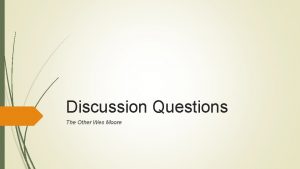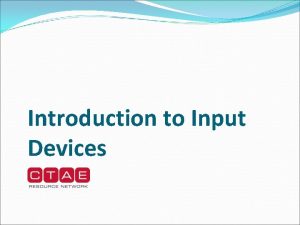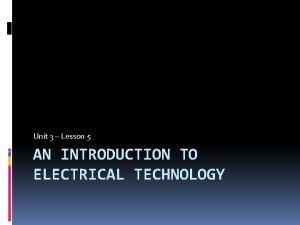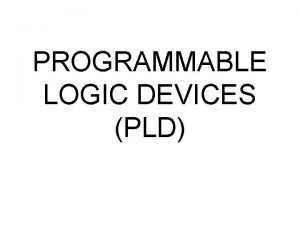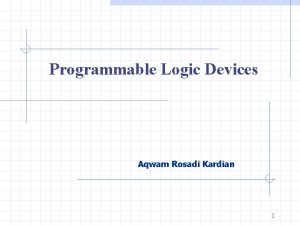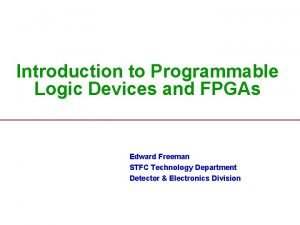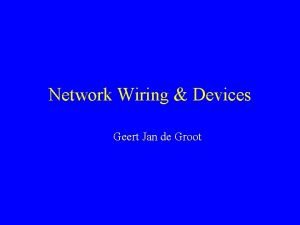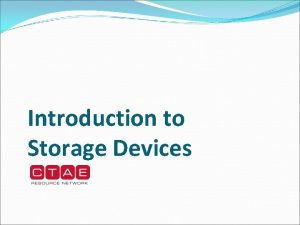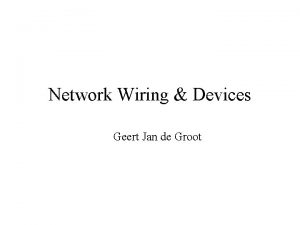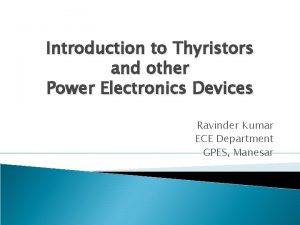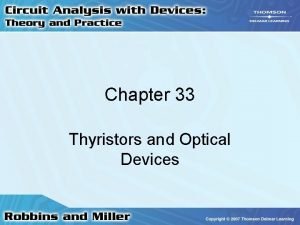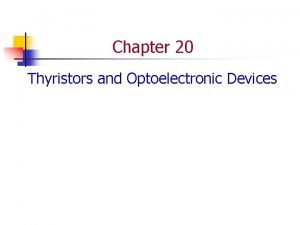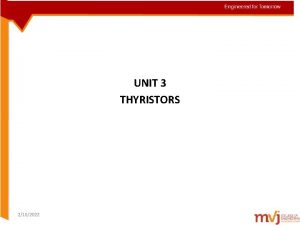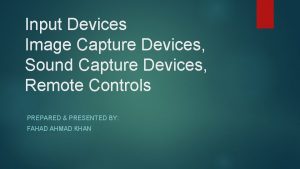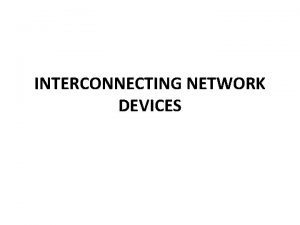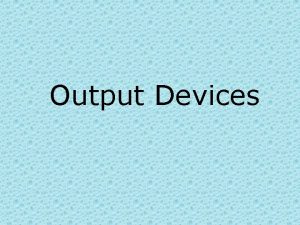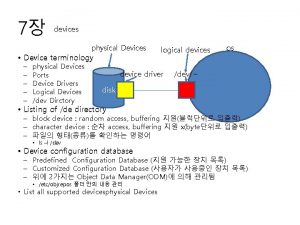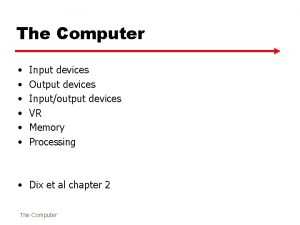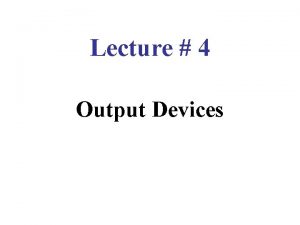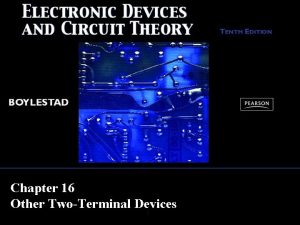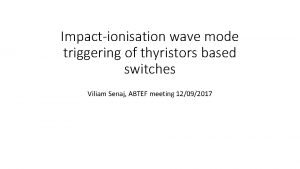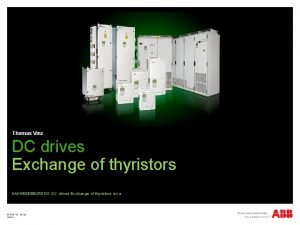Thyristors OTHER DEVICES Introduction Thyristors are a class

























- Slides: 25

Thyristors & OTHER DEVICES

Introduction Thyristors are a class of semiconductor devices characterized by 4 layers of alternating p- and n-material. Four-layer devices acts a either open or closed switches, for this reason, they are most frequently used in control applications Some thyristors and their symbols are: Shockley diode silicon-controlled rectifier

Introduction They stay on once they are triggered, and will go off only if current is too low or when triggered off. Applications: lamp dimmers, motor speed controls, ignition systems, charging circuits, etc. The 4 -layer diode (or Shockley diode) is a type of thyristor that acts something like an ordinary diode but conducts in the forward direction only after a certain anode to cathode voltage called the forwardbreakover voltage is reached. . It does not conduct when it is reverse-biased.

� Thyristors have three states: ◦ Reverse blocking mode — Voltage is applied in the direction that would be blocked by a diode ◦ Forward blocking mode — Voltage is applied in the direction that would cause a diode to conduct, but the thyristor has not been triggered into conduction ◦ Forward conducting mode — The thyristor has been triggered into conduction and will remain conducting until the forward current drops below a threshold value known as the "holding current"

� When the anode is at a positive potential VA with respect to the cathode with no voltage applied at the gate, junctions J 1 and J 3 are forward biased, while junction J 2 is reverse biased. As J 2 is reverse biased, no conduction takes place (Off state). Now if VA is increased beyond the breakdown voltage VBO of the thyristor, avalanche breakdown of J 2 takes place and the thyristor starts conducting (On state). � If a positive potential VG is applied at the gate terminal, the breakdown of the junction J 2 occurs at a lower value of VA. By selecting an appropriate value of VG, the thyristor can be switched into the on state quickly. � Once avalanche breakdown has occurred, the thyristor continues to conduct, irrespective of the gate voltage

� In a conventional thyristor, once it has been switched on by the VG, the device remains latched in the onstate (i. e. does not need a continuous supply of gate current to remain in the on state). As long as the anode remains positively biased, it cannot be switched off until the anode current falls below the holding current (IH). �A thyristor can be switched off if the external circuit causes the anode to become negatively biased. In some applications this is done by switching a second thyristor to discharge a capacitor into the cathode of the first thyristor. This method is called forced commutation.

Type of Thyristors � SCS — Silicon Controlled Switch or Thyristor Tetrode � SCR — Silicon Controlled Rectifier � DIAC-TRIAC — Triode for Alternating Current — A bidirectional switching device containing two thyristor structures with common gate contact � UJT-The Unijunction Transistor � PUT-Programmable Unijunction Transistor

Advantages and Disadvantages Advantages • Thyristors have low onstate conduction losses • Higher power handling capability than transistor • High blocking voltage rating Disadvantages • Worse switching performances than transistors. • Thyristor heating due to current flowing through them represents additional power losses in the distribution system • The thyristor system may also have a higher equipment cost

The Basic Four Layer Device The 4 -layer diode (or Shockley diode) is a type of thyristor that acts something like an ordinary diode but conducts in the forward direction only after a certain anode to cathode voltage called the forward-breakover voltage is reached. Equivalent circuit The 4 -layer diode has two leads, labeled the anode (A) and the cathode (K). The symbol reminds you that it acts like a diode. It does not conduct when it is reverse-biased.

The Basic Four Layer Device It will not conduct when reverse biased and will not conduct when forward biased until the forward breakover voltage (VBRF) is reached. It will continue to conduct as long as the holding current (IH) is maintained. Forwardconduction region Forward-blocking region Normal diode characteristics When FB, current is exponential function of voltage

Equivalent Circuits (4 Layers diode) The concept of 4 -layer devices is usually shown as an equivalent circuit of a pnp and an npn transistor. Ideally, these devices would not conduct, but when forward biased, if there is sufficient leakage current in the upper pnp device, it can acts as base current to the lower npn device causing it to conduct and bringing both transistors into saturation.

Silicon-Controlled Rectifier (SCR) is another four-layer pnpn device. � Has 3 terminals: anode, cathode, and gate. � In off state, it has a very high resistance. � In on state, there is a small on (forward) resistance. � Applications: motor controls, time-delay circuits, heater controls, phase controls, etc. � SCR

The Silicon-Controlled Rectifier The silicon-controlled rectifier (SCR) is a four layer device with three terminals, the anode, cathode, and gate. Equivalent Circuit

Silicon-Controlled Rectifier (SCR) The SCR had its roots in the 4 -layer diode. By adding a gate connection, the SCR could be triggered into conduction. This improvement made a much more useful device than the 4 -layer diode. The SCR can be turned on by exceeding the forward breakover voltage or by gate current. Notice that the gate current controls the amount of forward breakover voltage required for turning it on.

The Silicon-Controlled Rectifier Operation To switch on an SCR: • Forward bias the anode-cathode terminals (VF) AND • Apply sufficient gate voltage (Vgate) and gate current (IGT) Once an SCR is switched on, it remains latched on, even when the gate signal is removed. • • Holding current (IH) is the minimum required current from anode to cathode Reverse breakdown voltage is the maximum reverse bias voltage for the SCR

The Silicon-Controlled Rectifier Operation (Cont’d) To switch off an SCR: • Remove the power source the anode and cathode terminals OR • Reverse bias the anode and cathode terminals An SCR cannot be switched off by simply removing the gate voltage. Commutation circuitry can be used for satisfying either of the conditions for switching off an SCR.

Another applications Another application for SCRs is in crowbar circuits The purpose of a crowbar circuit is to shut down a power supply in case of over -voltage. Once triggered, the SCR latches on. The SCR can handle a large current, which causes the fuse (or circuit breaker) to open.

SCS—Silicon-Controlled Switch An SCS is like an SCR, except that it has two gates: a cathode gate and an anode gate. Operation Either gate can fire the SCS • A positive pulse or voltage on the cathode gate • A negative pulse or voltage on the anode gate Either gate can switch off the SCS • A negative pulse or voltage on the Cathode gate • A positive pulse or voltage on the anode gate Note: The anode gate requires higher voltages than the cathode gate. 18

The Diac and Triac The diac and triac unlike the SCR will conduct in both directions making it ideal for ac applications. The diac turns on when the breakover voltage is reached in either direction.

The Diac and Triac The triac is basically a diac with a gate terminal. The triac can be turned by a pulse at the gate.

The Diac and Triac In this basic triac phase control circuit R 1 controls the trigger point at which the triac turns on for each half of the cycle. The off time is called the delay angle and the on time is called the conduction angle.

The Unijunction Transistor (UJT) The UJT has one pn junction and is used mainly as a triggering device in thyristor circuits and can also be used in oscillator circuits. The symbol is similar to a JFET. Note the angle of the emtter. The other terminals are called base 1 and base 2. The characteristics are quite different than any other transistor.

The Unijunction Transistor (UJT) The resistive equivalent circuit of a UJT shown makes it easier to understand it’s operation. The emitter current controls the value of r’B 1 inversely. The total resistance or interbase resistance (r’BB) equals the sum of r’B 1 and r’B 2. The standoff ratio ( ) is the ratio r’B 1/ r’BB.

The Programmable Unijunction Transistor (PUT) Although it has the same name as a UJT the programmable unijunction transistor’s structure is not the same. It is actually more similar to an SCR. The anode to gate voltage is used to turn it off and on.

The Programmable Unijunction Transistor (PUT) The PUT can be “programmed” to turn on at a certain voltage by an external voltage divider. This yields a curve similar to a UJT therefore it can used in oscillator circuits like the UJT.
 Insidan region jh
Insidan region jh Self-initiated other-repair
Self-initiated other-repair Literary devices techniques
Literary devices techniques Computer architecture
Computer architecture The other wes moore book review
The other wes moore book review Introduction to poetry by billy collins figurative language
Introduction to poetry by billy collins figurative language Input devices
Input devices Magnetic inkcard reader
Magnetic inkcard reader Trapeze bar comfort device
Trapeze bar comfort device Lesson 5 introduction to electrical devices
Lesson 5 introduction to electrical devices The difference between fpga and pld is that
The difference between fpga and pld is that Logic devices for interfacing
Logic devices for interfacing Logic functions
Logic functions Poem introduction examples
Poem introduction examples Poetic devices
Poetic devices Advantages of plds
Advantages of plds Geert jan de groot
Geert jan de groot Introduction to storage
Introduction to storage Geert jan de groot
Geert jan de groot We have class today
We have class today Package mypackage class first class body
Package mypackage class first class body Introduction to ooad
Introduction to ooad Lower boundary of the modal class
Lower boundary of the modal class Class i vs class ii mhc
Class i vs class ii mhc Difference between abstract class and concrete class
Difference between abstract class and concrete class Determine the lower boundary of the modal class
Determine the lower boundary of the modal class




